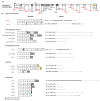AR Splicing Variants and Resistance to AR Targeting Agents
- PMID: 34071114
- PMCID: PMC8197115
- DOI: 10.3390/cancers13112563
AR Splicing Variants and Resistance to AR Targeting Agents
Abstract
Over the past decade, advances in prostate cancer research have led to discovery and development of novel biomarkers and effective treatments. As treatment options diversify, it is critical to further develop and use optimal biomarkers for the purpose of maximizing treatment benefit and minimizing unwanted adverse effects. Because most treatments for prostate cancer target androgen receptor (AR) signaling, aberrations affecting this drug target are likely to emerge following the development of castration-resistant prostate cancer (CRPC), and it is conceivable that such aberrations may play a role in drug resistance. Among the many AR aberrations, we and others have been studying androgen receptor splice variants (AR-Vs), especially AR-V7, and have conducted preclinical and clinical studies to develop and validate the clinical utility of AR-V7 as a prognostic and potential predictive biomarker. In this review, we first describe mechanisms of AR-V generation, regulation and their functions from a molecular perspective. We then discuss AR-Vs from a clinical perspective, focusing on the significance of AR-Vs detected in different types of human specimens and AR-Vs as potential therapeutic targets.
Keywords: AR-V7; androgen receptor splice variants; castration-resistant prostate cancer; circulating tumor cells.
Conflict of interest statement
J. Luo has served as a paid consultant/advisor for Sun Pharma, Janssen, Tolero, and Sanofi. J. Luo has received research funding to his institution from Orion, Astellas, Sanofi, Constellation, Calibr, Pandomedx, Cardiff Oncology, and Gilead, and is a co-inventor of a technology owned by Johns Hopkins University and licensed to Tokai, Qiagen, and A&G. E.S. Antonarakis is a paid consultant/advisor for Amgen, Astellas, AstraZeneca, Bayer, Blue Earth, Bristol Myers Squibb, Clovis, Constellation, Curium, Dendreon, Eli Lilly, ESSA, Exact Sciences, Foundation Medicine, GlaxoSmithKline, Invitae, Janssen, Merck and Sanofi; he has received research funding to his institution from AstraZeneca, Bayer, Bristol Myers Squibb, Celgene, Clovis, Constellation, Dendreon, Genentech, Janssen, Johnson & Johnson, Merck, Novartis, Orion and Sanofi; he is a co-inventor of a biomarker technology owned by Johns Hopkins University and licensed to Tokai and Qiagen. C.Lu is a co-inventor of a technology owned by Johns Hopkins University and licensed to Tokai, Qiagen.
Figures

Similar articles
-
Androgen receptor variant-driven prostate cancer II: advances in laboratory investigations.Prostate Cancer Prostatic Dis. 2020 Sep;23(3):381-397. doi: 10.1038/s41391-020-0217-3. Epub 2020 Mar 5. Prostate Cancer Prostatic Dis. 2020. PMID: 32139878 Free PMC article.
-
Standardization of CTC AR-V7 PCR assay and evaluation of its role in castration resistant prostate cancer progression.Prostate. 2019 Jan;79(1):54-61. doi: 10.1002/pros.23710. Epub 2018 Aug 23. Prostate. 2019. PMID: 30141201
-
Expression of Androgen Receptor Splice Variant 7 or 9 in Whole Blood Does Not Predict Response to Androgen-Axis-targeting Agents in Metastatic Castration-resistant Prostate Cancer.Eur Urol. 2018 Jun;73(6):818-821. doi: 10.1016/j.eururo.2018.01.007. Eur Urol. 2018. PMID: 29398263
-
Constitutively active androgen receptor splice variants AR-V3, AR-V7 and AR-V9 are co-expressed in castration-resistant prostate cancer metastases.Br J Cancer. 2018 Aug;119(3):347-356. doi: 10.1038/s41416-018-0172-0. Epub 2018 Jul 10. Br J Cancer. 2018. PMID: 29988112 Free PMC article.
-
Prognostic Value of Androgen Receptor Splice Variant 7 in the Treatment of Castration-resistant Prostate Cancer with Next generation Androgen Receptor Signal Inhibition: A Systematic Review and Meta-analysis.Eur Urol Focus. 2018 Jul;4(4):529-539. doi: 10.1016/j.euf.2017.01.004. Epub 2017 Jan 23. Eur Urol Focus. 2018. PMID: 28753843
Cited by
-
Insight into Recent Advances in Degrading Androgen Receptor for Castration-Resistant Prostate Cancer.Cancers (Basel). 2024 Feb 4;16(3):663. doi: 10.3390/cancers16030663. Cancers (Basel). 2024. PMID: 38339414 Free PMC article. Review.
-
The positive relationship between androgen receptor splice variant-7 expression and the risk of castration-resistant prostate cancer: A cumulative analysis.Front Oncol. 2023 Feb 14;13:1053111. doi: 10.3389/fonc.2023.1053111. eCollection 2023. Front Oncol. 2023. PMID: 36865799 Free PMC article.
-
PGC1α as a downstream effector of KDM5B promotes the progression of androgen receptor-positive and androgen receptor-negative prostate cancers.Am J Cancer Res. 2024 Sep 15;14(9):4367-4377. doi: 10.62347/QWZY6886. eCollection 2024. Am J Cancer Res. 2024. PMID: 39417173 Free PMC article.
-
International Union of Basic and Clinical Pharmacology CXIII: Nuclear Receptor Superfamily-Update 2023.Pharmacol Rev. 2023 Nov;75(6):1233-1318. doi: 10.1124/pharmrev.121.000436. Epub 2023 Aug 16. Pharmacol Rev. 2023. PMID: 37586884 Free PMC article. Review.
-
Androgen Receptor-Interacting Proteins in Prostate Cancer Development and Therapy Resistance.Am J Pathol. 2024 Mar;194(3):324-334. doi: 10.1016/j.ajpath.2023.12.003. Epub 2023 Dec 15. Am J Pathol. 2024. PMID: 38104650 Free PMC article. Review.
References
-
- Hu R., Dunn T.A., Wei S., Isharwal S., Veltri R.W., Humphreys E., Han M., Partin A.W., Vessella R.L., Isaacs W.B., et al. Ligand-independent androgen receptor variants derived from splicing of cryptic exons signify hormone-refractory prostate cancer. Cancer Res. 2009;69:16–22. doi: 10.1158/0008-5472.CAN-08-2764. - DOI - PMC - PubMed
-
- Chan S.C., Li Y., Dehm S.M. Androgen receptor splice variants activate androgen receptor target genes and support aberrant prostate cancer cell growth independent of canonical androgen receptor nuclear localization signal. J. Biol. Chem. 2012;287:19736–19749. doi: 10.1074/jbc.M112.352930. - DOI - PMC - PubMed
Publication types
Grants and funding
LinkOut - more resources
Full Text Sources
Other Literature Sources
Research Materials
Miscellaneous

